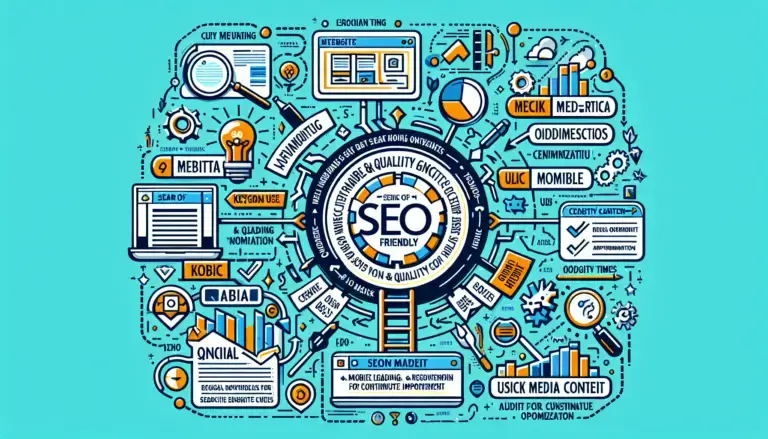Keyword research and optimization is the foundation of effective SEO-friendly content. It begins with identifying the phrases and terms that potential readers are using to find information related to your topic. Tools such as Google Keyword Planner, Moz Keyword Explorer, and Ahrefs can be instrumental in uncovering relevant keywords. Once you’ve identified these keywords, it’s essential to strategically incorporate them into your content to improve its visibility on search engines.
Start by selecting a primary keyword that closely aligns with the main topic of your article. This keyword should be integrated into your title, meta description, and the first 100-150 words of your content. Doing so ensures that search engines understand the main focus of your article early on. Beyond the primary keyword, also consider secondary keywords and related terms that enrich the context of your content. These should be naturally distributed throughout the body of the text to avoid keyword stuffing, which can harm your SEO efforts.
Long-tail keywords—phrases that are more specific and usually longer than general keywords—are also incredibly valuable. They often have lower search volumes but higher conversion rates because they target users closer to the point of purchase or decision-making. Including these in your content can help you attract a more targeted audience.
Additionally, semantic SEO involves using synonyms and related terms that provide context to your primary and secondary keywords. This approach helps search engines better understand the nuances of your content, improving the likelihood that it will rank for a variety of related searches. Implementing latent semantic indexing (LSI) keywords, which are contextually related phrases, can further enhance the depth and breadth of your article’s topic coverage.
Optimizing for user intent, or the reason behind a user’s search query, is another critical aspect. Create content that addresses the different types of user intent—informational, navigational, transactional, and commercial. Understand what your audience is looking for and tailor your content to meet those needs precisely.
Regularly updating your content to reflect current trends and maintain its relevance can give your SEO a continuous boost. Search engines favor fresh, up-to-date content that provides value to its readers. Conduct periodic audits to identify any gaps or opportunities for improvement and adjust your keyword strategy accordingly.
Quality and relevance of content

Quality and relevance of content are paramount when it comes to creating SEO-friendly content. High-quality content not only satisfies search engine algorithms but, more importantly, engages and retains your audience. To achieve this, focus on producing content that is informative, accurate, and valuable. Conduct thorough research to provide comprehensive insights and back your statements with credible sources. This builds trust and establishes your authority on the topic.
Content relevance ensures that what you write aligns closely with the audience’s needs and interests. Understanding your target audience is a crucial step in this process. Create detailed buyer personas to identify their pain points, preferences, and search behavior. Tailor your content to address these insights, making it more likely to resonate with your readers and fulfill their search intent.
Avoid fluff and filler content, as these can dilute the value of your article. Instead, focus on depth and detail, offering actionable advice, step-by-step guides, and clear explanations. Valuable content keeps readers on your page longer, which can reduce bounce rates and increase dwell time—two factors that search engines may consider when ranking your content.
Furthermore, readability plays a significant role in user experience and content consumption. Break down complex topics into simple, digestible pieces using clear and concise language. Utilize tools like Hemingway Editor or Grammarly to assess and improve your content’s readability. Organize your content logically with distinct sections and sub-sections, making it easy for readers to follow and understand the information you present.
Engage your audience by integrating visual elements such as images, infographics, videos, and charts. Visual content can break up text, illustrate points more vividly, and cater to different learning styles. Make sure that any visual content you include is directly related to the text and adds value, rather than serving as mere decoration.
Content length can also affect its quality and relevance. While there is no one-size-fits-all answer to how long your content should be, aim for a length that allows you to cover the topic thoroughly. Longer content often performs better in search rankings because it has the potential to provide more value and depth. However, prioritize quality over quantity to ensure that each word serves a purpose.
Ensuring grammatical accuracy and following proper spelling conventions are critical. Poor grammar and typographical errors can undermine your credibility and distract readers from the message you’re trying to convey. Proofread your content meticulously or enlist the help of professional editing services to ensure it is polished and error-free.
Lastly, ensure your content is mobile-friendly. With a significant portion of users accessing information via mobile devices, your content should be easily readable on smaller screens. Use responsive design principles and test your content across various devices to verify its accessibility.
Proper use of headings and formatting

Proper use of headings and formatting is crucial for creating SEO-friendly content. Clear and structured headings not only make your content more readable for users but also help search engines understand the hierarchy and key topics of your article.
Start by using headings (H1, H2, H3, etc.) to break your content into well-defined sections. The main title of your article should use an H1 tag, which is reserved for the primary topic. Subheadings (H2, H3, etc.) should be used to organize subtopics and provide a logical flow of information. This hierarchical structure helps both users and search engines navigate through your content more effectively.
In addition to improving readability, headings also offer an opportunity to include relevant keywords. However, ensure this is done naturally and avoid keyword stuffing, as this can lead to penalties from search engines. Incorporate primary and related keywords where they fit contextually, enhancing the likelihood your content will rank for those terms.
Formatting your content with bullet points, numbered lists, and short paragraphs can enhance the user experience. These elements make your content scannable, helping readers quickly find the information they are looking for. Search engines also favor content that is well-organized and easy to read, which can positively impact your rankings.
Another key aspect of formatting is the use of bold or italic text to emphasize important points. While these can draw attention to specific sections, use them sparingly to avoid overwhelming the reader. Emphasizing key points can help highlight the main takeaways and enhance the readability of your content.
Whitespace, or the empty space between elements of your content, is another critical component. Adequate whitespace prevents your content from appearing cluttered and improves overall readability. It also allows readers to focus on individual sections of your article without feeling overwhelmed by a wall of text.
Leveraging tools like content outlines or tables of contents for longer articles can benefit both users and search engines. These tools provide a quick overview of what the article covers, allowing users to jump to sections relevant to their interests. For search engines, an outline can offer additional context about the structure and key points of your content, potentially improving its search performance.
Optimized images and media

Optimized images and media are essential components of SEO-friendly content, enhancing both visual appeal and user engagement. To begin with, always use high-quality images that complement and elucidate the content. Avoid generic stock photos that add no real value. Instead, opt for original images or carefully curated visuals that enrich the narrative of your article.
When adding images, it’s crucial to incorporate descriptive filenames and alt text. The filename should include relevant keywords, rather than generic names like “image1.jpg.” For instance, if your article is about SEO tips, a filename like “seo-tips-keyword-research.jpg” would be more effective. Similarly, alt text should be descriptive and include keywords where appropriate. This not only helps visually impaired users but also offers search engines context about the image, improving your article’s SEO.
Image size and format are equally important. Large images can significantly slow down page load times, negatively affecting user experience and your search rankings. Use tools like TinyPNG or ImageOptim to compress images without compromising quality. When it comes to image formats, JPEG is generally preferred for photography and detailed visuals, while PNG is ideal for images requiring transparency.
Beyond static images, incorporating diverse media types such as videos, infographics, and slideshows can further engage your audience. Videos, in particular, can significantly boost user engagement metrics like time on page and reduce bounce rates. Ensure videos are properly embedded and accompanied by descriptive transcripts and summaries. This not only makes content accessible to a wider audience but also offers more text for search engines to crawl.
For infographics and charts, include alt text and consider providing a textual summary or explanation. This makes the data accessible to all users and provides additional content for search engines to index. Interactive elements like slideshows should also be user-friendly and load efficiently to prevent any hindrance to user experience.
Implementing lazy loading for images and videos can further enhance page performance by deferring the loading of non-critical resources until they are needed. This ensures that the primary content loads quickly, improving initial page load times.
Lastly, ensure that all media elements are responsive and compatible across different devices. Use CSS media queries to adjust image sizes and formats based on the viewer’s screen size. This ensures a seamless user experience, whether accessed from a mobile device, tablet, or desktop computer.
Internal and external linking

Internal and external linking plays a critical role in making your content more SEO-friendly. Internal linking involves creating hyperlinks that connect to other pages within your website. This practice not only helps search engines understand the structure and hierarchy of your site but also distributes page authority and improves crawl efficiency. A well-planned internal linking strategy can guide visitors to related content, thereby keeping them on your site longer and reducing bounce rates.
To implement effective internal linking, start by identifying key pages on your website that you want to rank higher. These could be cornerstone content, pillar pages, or any other significant articles. As you create new content, look for opportunities to link back to these key pages using relevant anchor text. The anchor text should be descriptive yet concise, giving both users and search engines an idea of the content they will find on the linked page.
Maintaining a natural flow is crucial when adding internal links. Avoid inserting too many links, which can make your content look spammy and disrupt reader engagement. Instead, focus on adding links where they naturally fit within the context of your content. Each link should provide additional value to the reader, whether it offers further reading, related insights, or complementary information.
External linking, on the other hand, involves adding hyperlinks that direct users to relevant content on other websites. While it might seem counterintuitive to send your readers elsewhere, well-placed external links can enhance your content’s credibility and provide additional value to your audience. They signal to search engines that your content is well-researched and connected to authoritative sources, which can positively impact your SEO.
When using external links, choose reputable and authoritative websites as your sources. Linking to high-quality, relevant content not only enhances your article’s credibility but also shows search engines that you are contributing to a network of reliable information. Use descriptive anchor text that clearly indicates the type of content being linked to, but ensure it blends seamlessly into your narrative.
Regularly audit your external links to ensure they remain functional and relevant. Broken links can create a poor user experience and potentially harm your site’s SEO. Tools such as Screaming Frog or Google Search Console can help you identify and fix broken links, ensuring your content remains polished and valuable.
It’s also beneficial to reach out to the websites you link to, informing them about the backlink. This could potentially open up opportunities for reciprocal linking, guest posts, or other collaborative efforts that can further enhance your SEO and outreach strategies.

